Spatiotemporal Characteristics of Carbon Emissions from Construction Land and Their Decoupling Effects in the Yellow River Basin, China
Abstract
1. Introduction
- (1)
- At the research scale of CE, the previous studies primarily focused on countries or provinces and cities and lacked a full investigation of CE in the geographical unit of the river basin. Especially under the background that the strategy of ecological safeguarding and high-quality development of the YRB has been elevated to a national strategy, the CE within the YRB needs to be further studied.
- (2)
- From the point of view of the spatiotemporal characterization of CE, although many scholars have fully explored the spatiotemporal characteristics of land-use CE, research on the spatiotemporal characteristics of CECL, which is a prominent source of carbon is still relatively lacking, especially on the direction of the distribution of CECL in the region, the location of the gravity center and the trajectory of migration. This deficiency is unfavorable to a deep understanding of regional differences in CECL.
- (3)
- From the standpoint of decoupling analysis, scholars have adopted the Tapio decoupling model to measure the relationship between CE and EG in industry, agriculture, tourism, transportation, etc, while the degree of decoupling between CECL and EG has not been clarified.
- (4)
- From the perspective of the components of the LMDI decomposition model, previous studies have mainly decomposed the drives of CE into the population, economy, structure of energy, and industrial structure, and very few scholars have considered the influence of the CL area factor on CE. In our study, we take the CL area as an important factor in the impact factor decomposition model.
2. Materials and Methods
2.1. Study Area
2.2. Research Framework
2.3. Data Sources
2.4. Methods
2.4.1. Calculation Method of CECL
2.4.2. Standard Deviational Ellipse
2.4.3. Tapio Decoupling Model
2.4.4. Decoupling Index Decomposition Model Based on Kaya-LMDI
3. Results
3.1. Temporal and Spatial Features of CECL
3.1.1. Time Series Characteristics Analysis of the CECL in YRB
3.1.2. Spatial Characteristic Analysis of CECL in YRB
3.1.3. SDE Analysis of CECL
3.2. Decoupling Analysis of EG and CECL
3.2.1. Time Series Characteristics of Decoupling Status
3.2.2. Spatial Evolution Features of Decoupling State
3.3. LMDI Factor Decomposition Results Analysis
4. Discussion
4.1. Characteristics of Spatiotemporal Variations of CECL
4.2. Standard Deviation Ellipse (SDE) of CECL
4.3. Decoupling Analysis of CECL
4.4. Analysis of the Drivers
5. Conclusions
Author Contributions
Funding
Data Availability Statement
Acknowledgments
Conflicts of Interest
Abbreviations
| CE | carbon emissions |
| CL | construction land |
| CECL | carbon emissions from construction land |
| EG | economic growth |
| YRB | Yellow River Basin |
| LMDI | Logarithmic Mean Divisia Index |
| SDE | standard deviation ellipse |
| WD | weak decoupling |
| SD | strong decoupling |
References
- Li, M.; Liu, H.; Yu, S.; Wang, J.; Miao, Y.; Wang, C. Estimating the Decoupling between Net Carbon Emissions and Construction Land and Its Driving Factors: Evidence from Shandong Province, China. Int. J. Environ. Res. Public Health 2022, 19, 8910. [Google Scholar] [CrossRef] [PubMed]
- Nepal, R.; Paija, N. A multivariate time series analysis of energy consumption, real output and pollutant emissions in a developing economy: New evidence from Nepal. Econ. Model. 2019, 77, 164–173. [Google Scholar] [CrossRef]
- Yang, S.; Yang, D.; Shi, W.; Deng, C.; Chen, C.; Feng, S. Global evaluation of carbon neutrality and peak carbon dioxide emissions: Current challenges and future outlook. Environ. Sci. Pollut. Res. 2023, 30, 81725–81744. [Google Scholar] [CrossRef]
- Bamminger, C.; Poll, C.; Marhan, S. Offsetting global warming-induced elevated greenhouse gas emissions from an arable soil by biochar application. Glob. Change Biol. 2018, 24, 318–334. [Google Scholar] [CrossRef]
- Meng, H.; Zhang, X.; Du, X.; Du, K. Spatiotemporal Heterogeneity of the Characteristics and Influencing Factors of Energy-Consumption-Related Carbon Emissions in Jiangsu Province Based on DMSP-OLS and NPP-VIIRS. Land 2023, 12, 1369. [Google Scholar] [CrossRef]
- Wang, Q.; Yang, C.; Wang, M.; Zhao, L.; Zhao, Y.; Zhang, Q.; Zhang, C. Decoupling analysis to assess the impact of land use patterns on carbon emissions: A case study in the Yellow River Delta efficient eco-economic zone, China. J. Clean. Prod. 2023, 412, 137415. [Google Scholar] [CrossRef]
- Meng, Q.; Zheng, Y.; Liu, Q.; Li, B.; Wei, H. Analysis of spatiotemporal variation and influencing factors of land-use carbon emissions in nine provinces of the Yellow River Basin based on the LMDI model. Land 2023, 12, 437. [Google Scholar] [CrossRef]
- Zhang, C.; Zhao, L.; Zhang, H.; Chen, M.; Fang, R.; Yao, Y.; Zhang, Q.; Wang, Q. Spatial-temporal characteristics of carbon emissions from land use change in Yellow River Delta region, China. Ecol. Indic. 2022, 136, 108623. [Google Scholar] [CrossRef]
- He, J.; Yang, J. Spatial–Temporal Characteristics and Influencing Factors of Land-Use Carbon Emissions: An Empirical Analysis Based on the GTWR Model. Land 2023, 12, 1506. [Google Scholar] [CrossRef]
- Wu, S.; Hu, S.; Frazier, A. Spatiotemporal variation and driving factors of carbon emissions in three industrial land spaces in China from 1997 to 2016. Technol. Forecast. Soc. Change 2021, 169, 120837. [Google Scholar] [CrossRef]
- Zhang, T.; Chen, L.; Yu, Z.; Zang, J.; Li, L. Spatiotemporal Evolution Characteristics of Carbon Emissions from Industrial Land in Anhui Province, China. Land 2022, 11, 2084. [Google Scholar] [CrossRef]
- Guo, Y.; Yin, W.; Chai, Q.; Yu, A.; Zhao, C.; Fan, Z.; Fan, H.; Coulter, J.A. No tillage and previous residual plastic mulching with reduced water and nitrogen supply reduces soil carbon emission and enhances productivity of following wheat in arid irrigation areas. Field Crop. Res. 2021, 262, 108028. [Google Scholar] [CrossRef]
- Wu, H.; Ding, B.; Liu, L.; Zhou, L.; Meng, Y.; Zheng, X. Have Agricultural Land-Use Carbon Emissions in China Peaked? An Analysis Based on Decoupling Theory and Spatial EKC Model. Land 2024, 13, 585. [Google Scholar] [CrossRef]
- Dutra, D.; Silveira, M.; Mataveli, G.; Ferro, P.; da Silva Magalhães, D.; de Medeiros, T.; Anderson, L. Challenges for reducing carbon emissions from land-use and land cover change in Brazil. Perspect. Ecol. Conserv. 2024, 22, 213–218. [Google Scholar] [CrossRef]
- Kafy, A.; Al Rakib, A.; Fattah, M.; Rahaman, Z.; Sattar, G. Impact of vegetation cover loss on surface temperature and carbon emission in a fastest-growing city, Cumilla, Bangladesh. Build. Environ. 2022, 208, 108573. [Google Scholar] [CrossRef]
- Lin, Q.; Zhang, L.; Qiu, B.; Zhao, Y.; Wei, C. Spatiotemporal analysis of land use patterns on carbon emissions in China. Land 2021, 10, 141. [Google Scholar] [CrossRef]
- Peng, J.; Zheng, Y.; Liu, C. The Impact of Urban Construction Land Use Change on Carbon Emissions: Evidence from the China Land Market in 2000–2019. Land 2022, 11, 1440. [Google Scholar] [CrossRef]
- Wang, M.; Wang, Y.; Wu, Y.; Yue, X.; Wang, M.; Hu, P. Detecting Differences in the Impact of Construction Land Types on Carbon Emissions: A Case Study of Southwest China. Land 2022, 11, 719. [Google Scholar] [CrossRef]
- Chuai, X.; Yuan, Y.; Zhang, X.; Guo, X.; Zhang, X.; Xie, F.; Zhao, R.; Li, J. Multiangle land use-linked carbon balance examination in Nanjing City, China. Land Use Pol. 2019, 84, 305–315. [Google Scholar] [CrossRef]
- Niu, X.; Liao, F.; Mi, Z.; Wu, G. The Impact of Urban Construction Land Expansion on Carbon Emissions from the Perspective of the Yangtze River Delta Integration, China. Land 2024, 13, 911. [Google Scholar] [CrossRef]
- Lin, G. The redevelopment of China’s construction land: Practising land property rights in cities through renewals. China Q. 2015, 224, 865–887. [Google Scholar] [CrossRef]
- Yan, H.; Guo, X.; Zhao, S.; Yang, H. Variation of Net Carbon Emissions from Land Use Change in the Beijing-Tianjin-Hebei Region during 1990–2020. Land 2022, 11, 997. [Google Scholar] [CrossRef]
- Tan, Y.; Liu, Y.; Chen, Y.; Zhang, Z.; Wu, D.; Chen, H.; Han, Y. The Impact of Urban Construction Land Change on Carbon Emissions—A Case Study of Wuhan City. Int. J. Environ. Res. Public Health 2023, 20, 922. [Google Scholar] [CrossRef] [PubMed]
- Li, Y.; Cai, M.; Wu, K.; Wei, J. Decoupling analysis of carbon emission from construction land in Shanghai. J. Clean. Prod. 2019, 210, 25–34. [Google Scholar] [CrossRef]
- Cai, Y.; Li, K. Spatiotemporal dynamic evolution and influencing factors of land use carbon emissions: Evidence from Jiangsu Province, China. Front. Environ. Sci. 2024, 12, 1368205. [Google Scholar] [CrossRef]
- Tapio, P. Towards a theory of decoopling: Degrees of decoupling in the EU and the case of road traffic in Finland between 1970 and 2001. Transp. Policy 2005, 12, 137–151. [Google Scholar] [CrossRef]
- Jia, L.; Wang, M.; Yang, S.; Zhang, F.; Wang, Y.; Li, P.; Ma, W.; Sui, S.; Liu, T.; Wang, M. Analysis of Agricultural Carbon Emissions and Carbon Sinks in the Yellow River Basin Based on LMDI and Tapio Decoupling Models. Sustainability 2024, 16, 468. [Google Scholar] [CrossRef]
- Yang, B.; Wang, Y.; Dunya, R.; Xiang, S. Study on the driving factors and decoupling effect of carbon emission from pig farming in China—Based on LMDI and Tapio model. Environ. Dev. Sustain. 2023, 25, 1–31. [Google Scholar] [CrossRef]
- Zha, J.; Dai, J.; Ma, S.; Chen, Y.; Wang, X. How to decouple tourism growth from carbon emissions? A case study of Chengdu, China. Tour. Manag. Perspect. 2021, 39, 100849. [Google Scholar] [CrossRef]
- Tang, Y.; Jiang, H.; Yang, X.; Zhang, D. Decoupling effect and influencing factors of transportation carbon emissions in Hainan Province. IEEE Access 2024, 12, 131750–131761. [Google Scholar] [CrossRef]
- Ang, B.; Liu, F. A new energy decomposition method: Perfect in decomposition and consistent in aggregation. Energy 2001, 26, 537–548. [Google Scholar] [CrossRef]
- Chun, T.; Wang, S.; Xue, X.; Xin, H.; Gao, G.; Wang, N.; Tian, X.; Zhang, R. Decomposition and decoupling analysis of multi-sector CO2 emissions based on LMDI and Tapio models: Case study of Henan Province, China. Environ. Sci. Pollut. Res. 2023, 30, 88508–88523. [Google Scholar] [CrossRef] [PubMed]
- Wang, M.; Xiang, Z.; An, Q.; Zhuo, Y.; Du, X.; Wang, P. Study on green and low-carbon development in Qinghai Province Based on decoupling index and LMDI. Adv. Clim. Change Res. 2021, 17, 598–607. [Google Scholar] [CrossRef]
- Chen, L.; Thapa, B.; Yan, W. The relationship between tourism, carbon dioxide emissions, and economic growth in the Yangtze River Delta, China. Sustainability 2018, 10, 2118. [Google Scholar] [CrossRef]
- Guan, Q. Decomposing and Decoupling the Energy-Related Carbon Emissions in the Beijing–Tianjin–Hebei Region Using the Extended LMDI and Tapio Index Model. Sustainability 2023, 15, 9681. [Google Scholar] [CrossRef]
- Wang, S.; Sun, P.; Sun, H.; Liu, Q.; Liu, S.; Lu, D. Spatiotemporal Variations of Carbon Emissions and Their Driving Factors in the Yellow River Basin. Int. J. Environ. Res. Public Health 2022, 19, 12884. [Google Scholar] [CrossRef]
- Wu, H.; Yang, Y.; Li, W. Analysis of spatiotemporal evolution characteristics and peak forecast of provincial carbon emissions under the dual carbon goal: Considering nine provinces in the Yellow River basin of China as an example. Atmos. Pollut. Res. 2023, 14, 101828. [Google Scholar] [CrossRef]
- Zhao, J.; Kou, L.; Wang, H.; He, X.; Xiong, Z.; Liu, C.; Cui, H. Carbon Emission Prediction Model and Analysis in the Yellow River Basin Based on a Machine Learning Method. Sustainability 2022, 14, 6153. [Google Scholar] [CrossRef]
- Wei, X.; Zhang, L.; He, Y.; Gao, Y.; Yao, X.; Ding, Y.; Guo, Y. Spatiotemporal characteristics and prediction of ecological safety in the Yellow River Basin of China. IEEE J. Sel. Top. Appl. Earth Obs. Remote Sens. 2024, 17, 16119–16138. [Google Scholar] [CrossRef]
- Yu, Y.; Hua, T.; Chen, L.; Zhang, Z.; Paulo, P. Divergent changes in vegetation greenness, productivity, and rainfall use efficiency are characteristic of ecological restoration towards high-quality development in the Yellow River Basin, China. Engineering 2024, 34, 109–119. [Google Scholar] [CrossRef]
- Wang, H.; Ma, T. Optimal water resource allocation considering virtual water trade in the Yellow River Basin. Sci. Rep. 2024, 14, 79. [Google Scholar] [CrossRef] [PubMed]
- Lai, Z.; Li, L.; Huang, M.; Tao, Z.; Shi, X.; Li, T. Spatiotemporal evolution and decoupling effects of sustainable water resources utilization in the Yellow River Basin: Based on three-dimensional water ecological footprint. J. Environ. Manag. 2024, 366, 121846. [Google Scholar] [CrossRef] [PubMed]
- Wang, H.; Wu, L.; Yue, Y.; Jin, Y.; Zhang, B. Impacts of climate and land use change on terrestrial carbon storage: A multi-scenario case study in the Yellow River Basin (1992–2050). Sci. Total Environ. 2024, 930, 172557. [Google Scholar] [CrossRef]
- Li, H.; Mu, H.; Jian, S.; Li, X. Assessment of Rainfall and Temperature Trends in the Yellow River Basin, China from 2023 to 2100. Water 2024, 16, 1441. [Google Scholar] [CrossRef]
- Feng, Y.; Zhu, A. Spatiotemporal differentiation and driving patterns of water utilization intensity in Yellow River Basin of China: Comprehensive perspective on the water quantity and quality. J. Clean. Prod. 2022, 369, 133395. [Google Scholar] [CrossRef]
- Liu, K.; Qiao, Y.; Shi, T.; Zhou, Q. Study on coupling coordination and spatiotemporal heterogeneity between economic development and ecological environment of cities along the Yellow River Basin. Environ. Sci. Pollut. Res. 2021, 28, 6898–6912. [Google Scholar] [CrossRef]
- Yin, Y.; Peng, W.; Xie, X. Spatial-temporal characteristics and obstacle factors analysis of urban resources and environment carrying capacity in the Yellow River Basin cities. Environ. Dev. Sustain. 2023, 25, 1–20. [Google Scholar] [CrossRef]
- Zhang, Z.; Hu, B.; Qiu, H. Comprehensive evaluation of resource and environmental carrying capacity based on SDGs perspective and Three-dimensional Balance Mode. Ecol. Indic. 2022, 138, 108788. [Google Scholar] [CrossRef]
- Fang, Z.; Ding, T.; Chen, J.; Xue, S.; Zhou, Q.; Wang, Y.; Wang, Y.; Huang, Z.; Yang, S. Impacts of land use/land cover changes on ecosystem services in ecologically fragile regions. Sci. Total Environ. 2022, 831, 154967. [Google Scholar] [CrossRef]
- Pan, L.; Yu, J.; Lin, L. The temporal and spatial pattern evolution of land-use carbon emissions in China coastal regions and its response to green economic development. Front. Environ. Sci. 2022, 10, 1018372. [Google Scholar] [CrossRef]
- Yang, B.; Chen, X.; Wang, Z.; Li, W.; Zhang, C.; Yao, X. Analyzing land use structure efficiency with carbon emissions: A case study in the Middle Reaches of the Yangtze River, China. J. Clean. Prod. 2020, 274, 123076. [Google Scholar] [CrossRef]
- Wei, W.; Li, Y.; Ma, L.; Xie, B.; Hao, R.; Chen, D.; Yang, S. Carbon emission change based on land use in Gansu Province. Environ. Monit. Assess. 2024, 196, 311. [Google Scholar] [CrossRef] [PubMed]
- Hu, Y.; Zhang, K.; Hu, N.; Wu, L. A review of agricultural carbon emission measurement in China. Chin. J. Eco Agric. 2023, 31, 163–176. [Google Scholar] [CrossRef]
- Gui, D.; He, H.; Liu, C.; Han, S. Spatio-temporal dynamic evolution of carbon emissions from land use change in Guangdong Province, China, 2000–2020. Ecol. Indic. 2023, 156, 111131. [Google Scholar] [CrossRef]
- Lefever, D.W. Measuring geographic concentration by means of the standard deviational ellipse. Am. J. Sociol. 1926, 32, 88–94. [Google Scholar] [CrossRef]
- Duman, Z.; Mao, X.; Cai, B.; Zhang, Q.; Chen, Y.; Gao, Y.; Guo, Z. Exploring the spatiotemporalpattern evolution of carbon emissions and air pollution in Chinesecities. J. Environ. Manag. 2023, 345, 118870. [Google Scholar] [CrossRef] [PubMed]
- Wang, W.; Samat, A.; Abuduwaili, J.; Ge, Y. Spatio-temporal variations of satellite-based PM2.5 concentrations and its determinants in Xinjiang, northwest of China. Int. J. Environ. Res. Public Health 2020, 17, 2157. [Google Scholar] [CrossRef]
- Kaya, Y. Impact of Carbon Dioxide Emission Control on GNP Growth: Interpretation of Proposed Scenarios; IPCC Energy and Industry Subgroup, Response Strategies Working Group: Paris, France, 1989. [Google Scholar]
- Yuan, Y.; Lu, Y.; Xie, J.; Tao, J.; Chuai, X.; Huang, S.; Pu, L. Decoupling and decomposition analysis of industrial carbon emissions and economic growth in China from a dynamic perspective. Environ. Dev. Sustain. 2024, 26, 1–23. [Google Scholar] [CrossRef]
- Kong, H.; Shi, L.; Da, D.; Li, Z.; Tang, D.; Xing, W. Simulation of China’s Carbon Emission Based on Influencing Factors. Energies 2022, 15, 3272. [Google Scholar] [CrossRef]
- Feng, Y.; Peng, D.; Li, Y.; Liu, S. Can regional integration reduce carbon intensity? Evidence from city cluster in China. Environ. Dev. Sustain. 2024, 26, 5249–5274. [Google Scholar] [CrossRef]
- Wang, X.; Lu, Z.; Li, T.; Zhang, P. Carbon-neutral power system transition pathways for coal-dominant and renewable Resource-abundant regions: Inner Mongolia as a case study. Energy Convers. Manag. 2023, 285, 117013. [Google Scholar] [CrossRef]
- Zhang, J.; Lu, H.; Peng, W.; Zhang, L. Analyzing carbon emissions and influencing factors in Chengdu-Chongqing urban agglomeration counties. J. Environ. Sci. 2025, 151, 640–651. [Google Scholar] [CrossRef]
- Wang, L.; Fan, J.; Wang, J.; Zhao, Y.; Li, Z.; Guo, R. Spatio-temporal characteristics of the relationship between carbon emissions and economic growth in China’s transportation industry. Environ. Sci. Pollut. Res. 2020, 27, 32962–32979. [Google Scholar] [CrossRef]
- Li, Q.; Wu, S.; Lei, Y.; Li, S.; Li, L. Evolutionary path and driving forces of inter-industry transfer of CO2 emissions in China: Evidence from structural path and decomposition analysis. Sci. Total Environ. 2021, 765, 142773. [Google Scholar] [CrossRef] [PubMed]
- Zhang, H.; Feng, C.; Zhou, X. Going carbon-neutral in China: Does the low-carbon city pilot policy improve carbon emission efficiency? Sustain. Prod. Consum. 2022, 33, 312–329. [Google Scholar] [CrossRef]
- Hou, X.; Hu, Q.; Liang, X.; Xu, J. How do low-carbon city pilots affect carbon emissions? Staggered difference in difference evidence from Chinese firms. Econ. Anal. Policy 2023, 79, 664–686. [Google Scholar] [CrossRef]
- Zhao, X.; Ma, X.; Chen, B.; Shang, Y.; Song, M. Challenges toward carbon neutrality in China: Strategies and countermeasures. Resour. Conserv. Recycl. 2022, 176, 105959. [Google Scholar] [CrossRef]
- Wang, X.; Zhao, X.; Zhang, S.; Shi, S.; Zhang, X. Decoupling Effect and Driving Factors of Land-Use Carbon Emissions in the Yellow River Basin Using Remote Sensing Data. Remote Sens. 2023, 15, 4446. [Google Scholar] [CrossRef]
- Li, R.; Li, L.; Wang, Q. The impact of energy efficiency on carbon emissions: Evidence from the transportation sector in Chinese 30 provinces. Sustain. Cities Soc. 2022, 82, 103880. [Google Scholar] [CrossRef]
- Lian, W.; Sun, X.; Xing, W.; Gao, T.; Duan, H. Coordinated development and driving factor heterogeneity of different types of urban agglomeration carbon emissions in China. Environ. Sci. Pollut. Res. 2023, 30, 35034–35053. [Google Scholar] [CrossRef]
- Wang, K.; Li, Z.; Xu, Z.; Wang, J.; Jia, M.; Wang, L.; Xin, Y.; Duo, X. Evaluating and simulating the impacts of land use patterns on carbon emissions in coal resource-based regions: A case study of shanxi province, China. J. Clean. Prod. 2024, 458, 142494. [Google Scholar] [CrossRef]
- Yan, X.; Wang, X. Evaluation and Analysis of Synergy between Energy and Environmental Policies in Coal Resource-Rich Areas. Sustainability 2024, 16, 2623. [Google Scholar] [CrossRef]
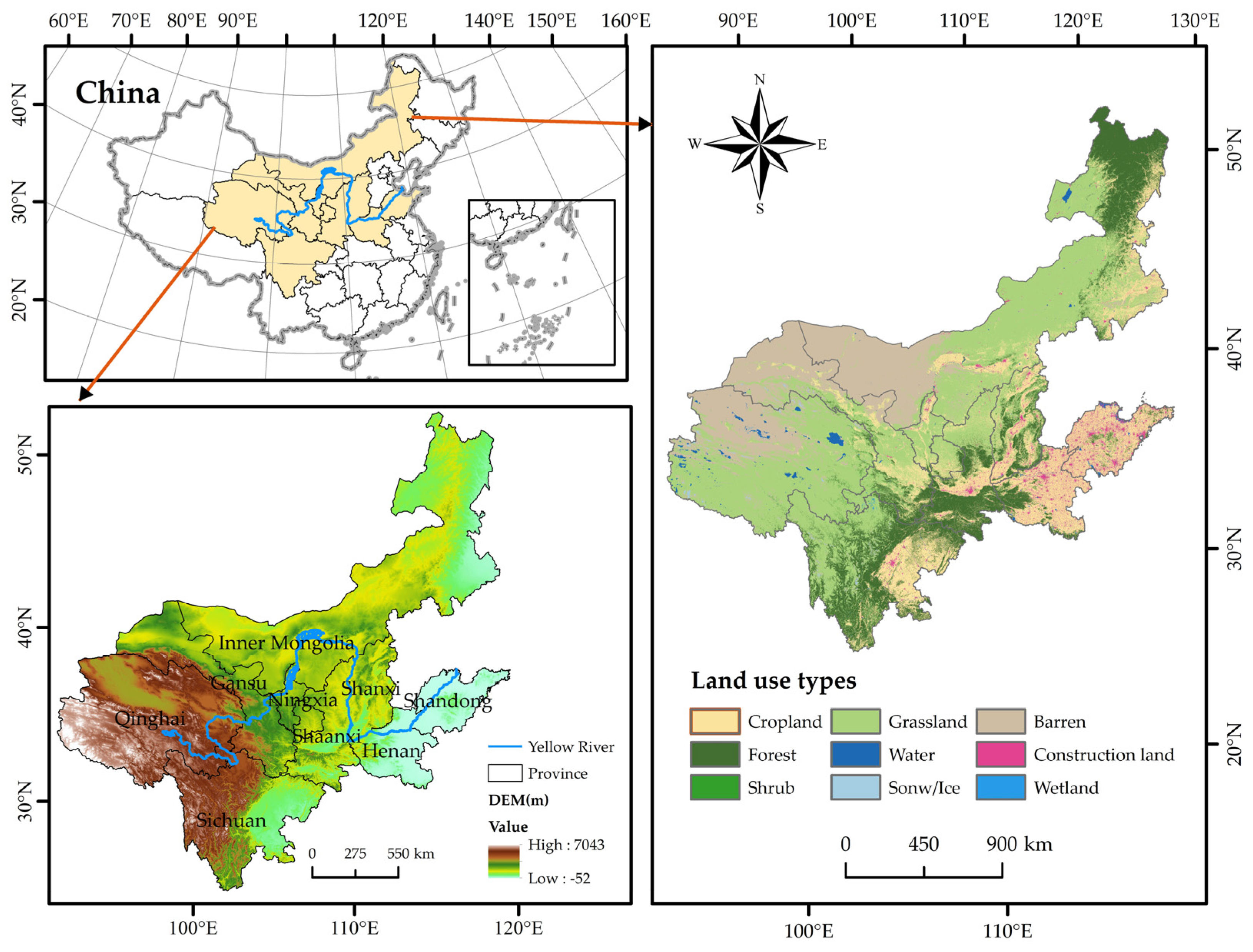
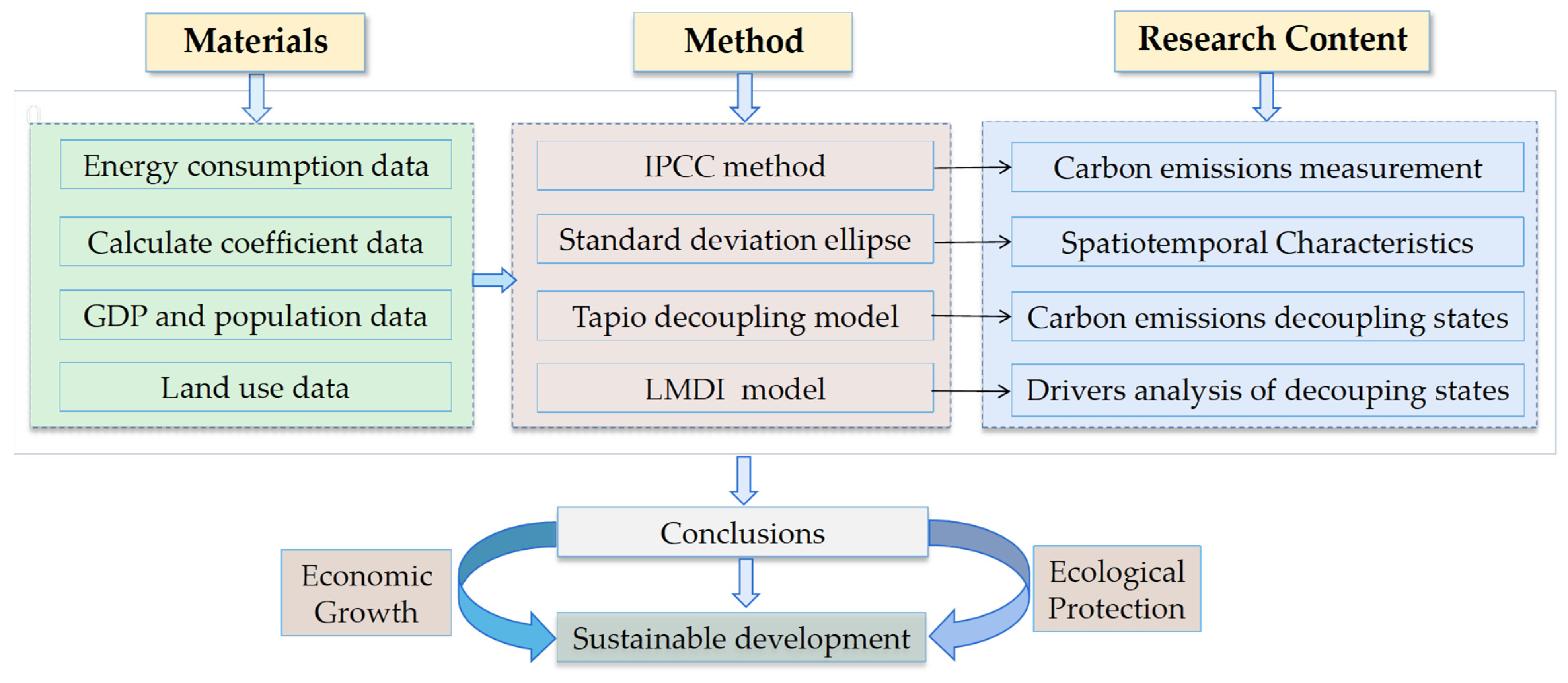

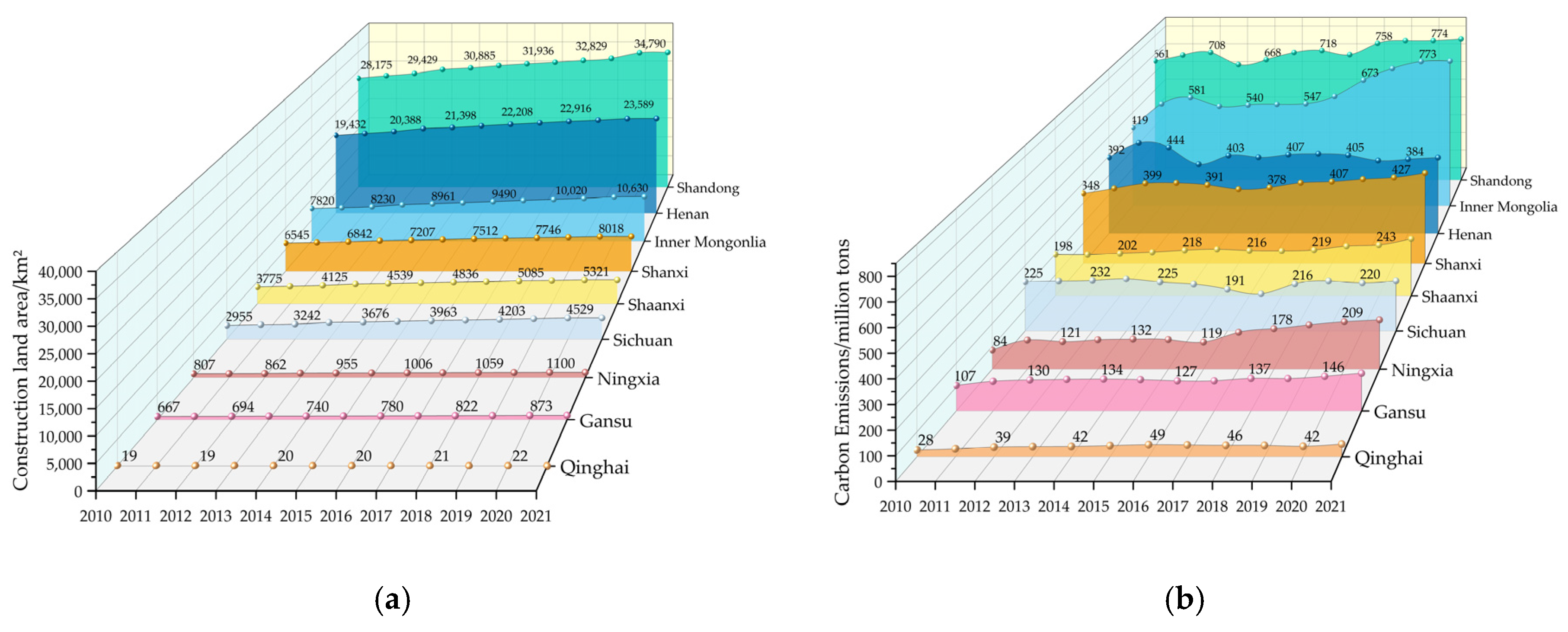
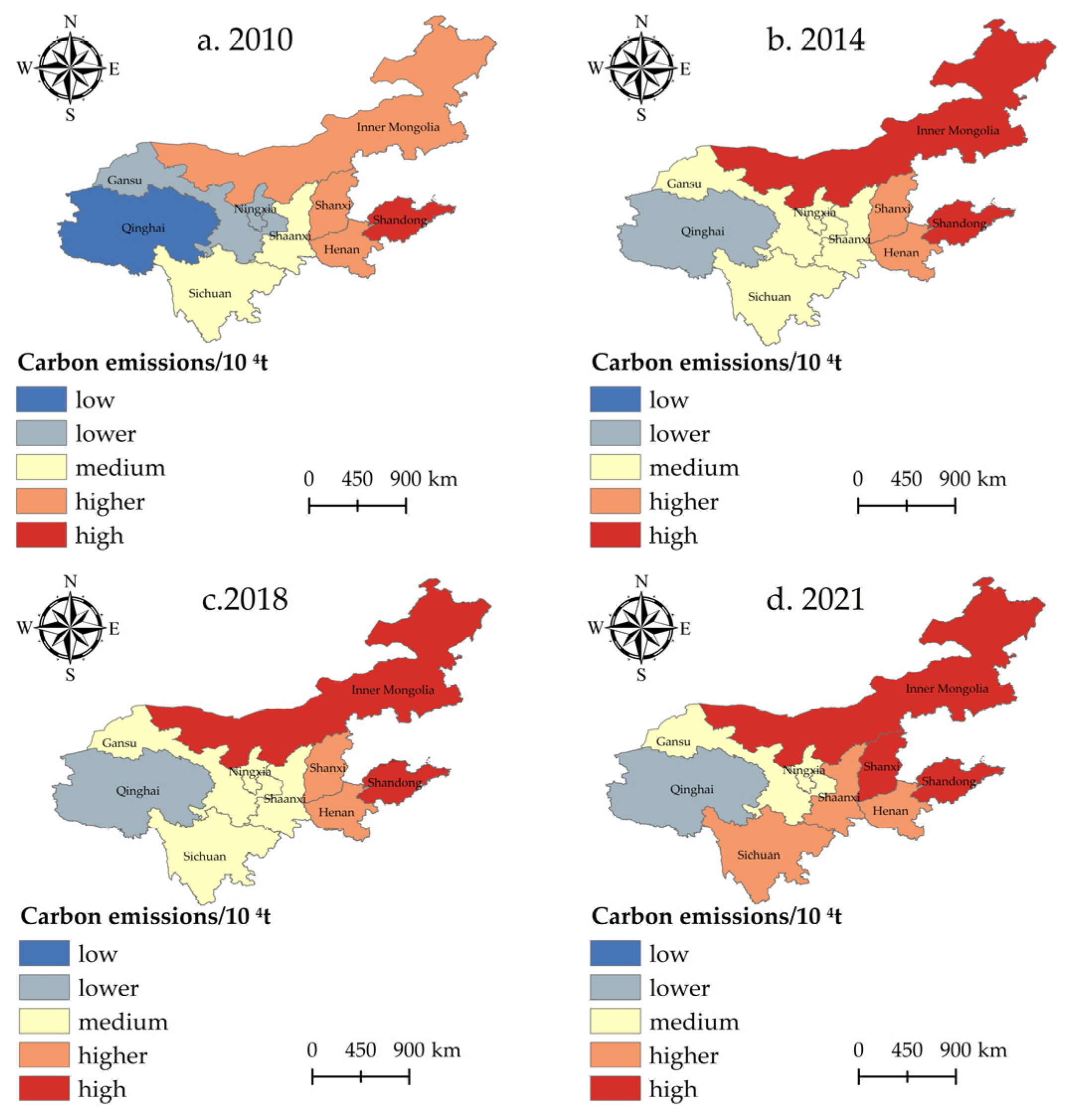
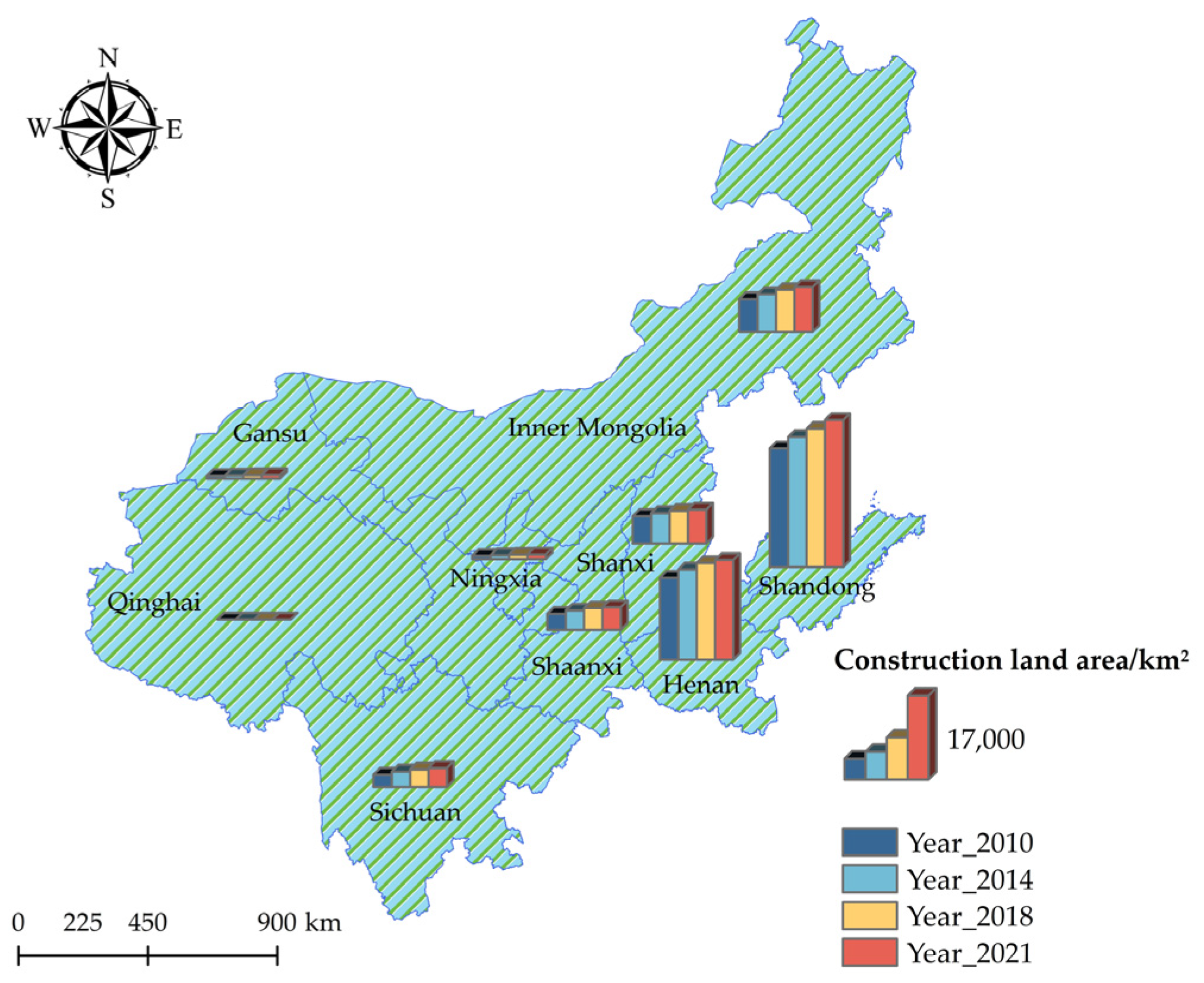
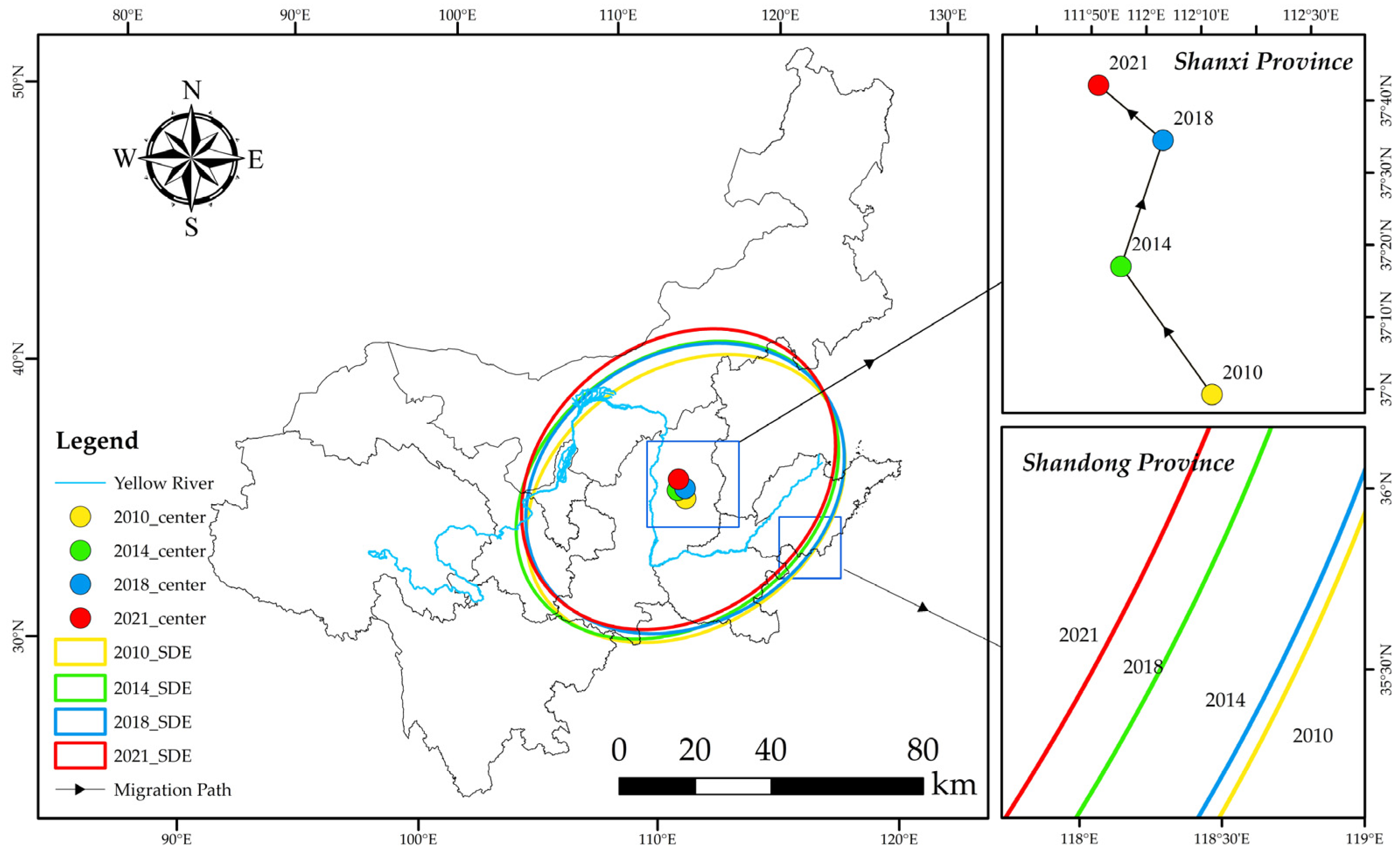
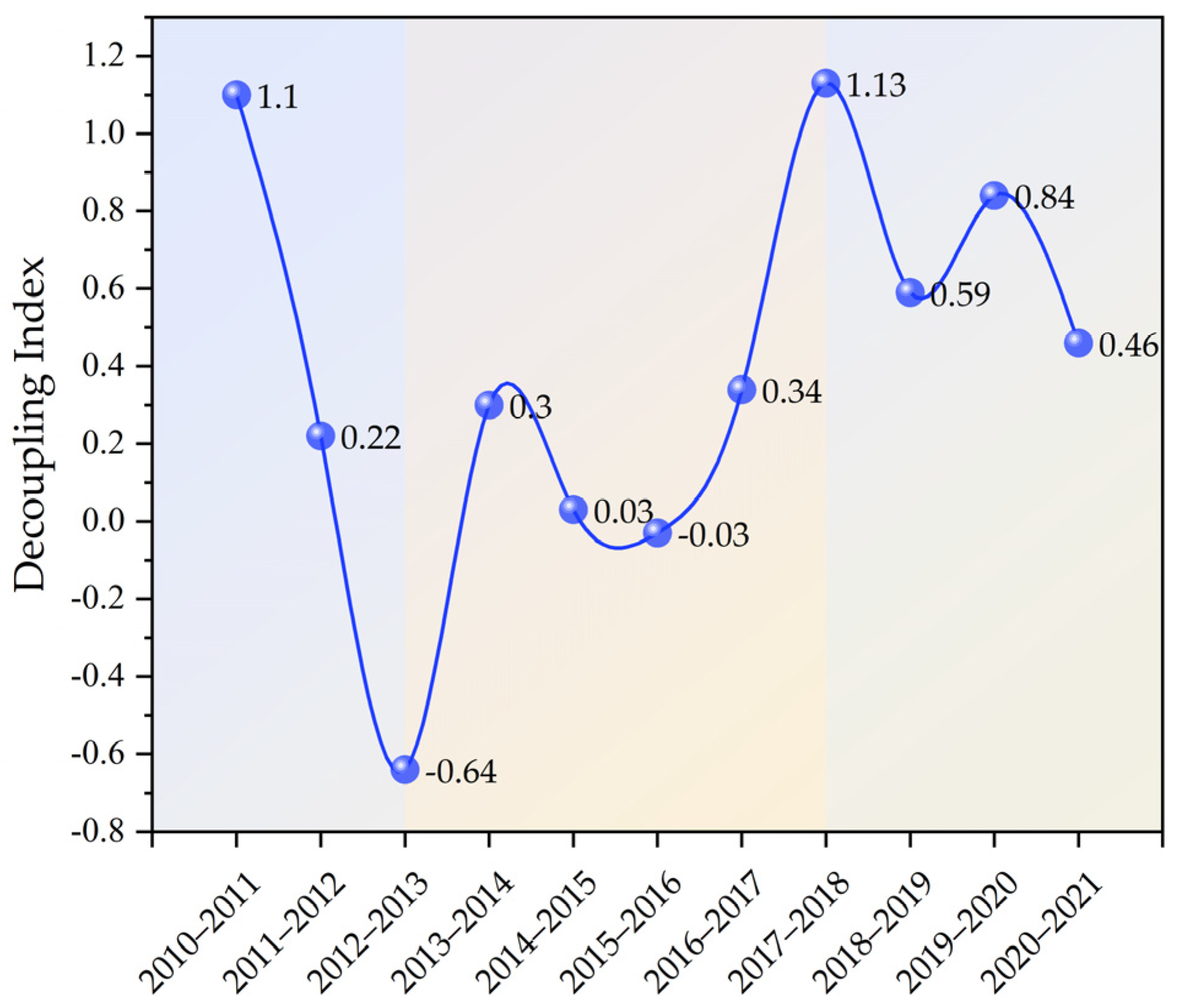
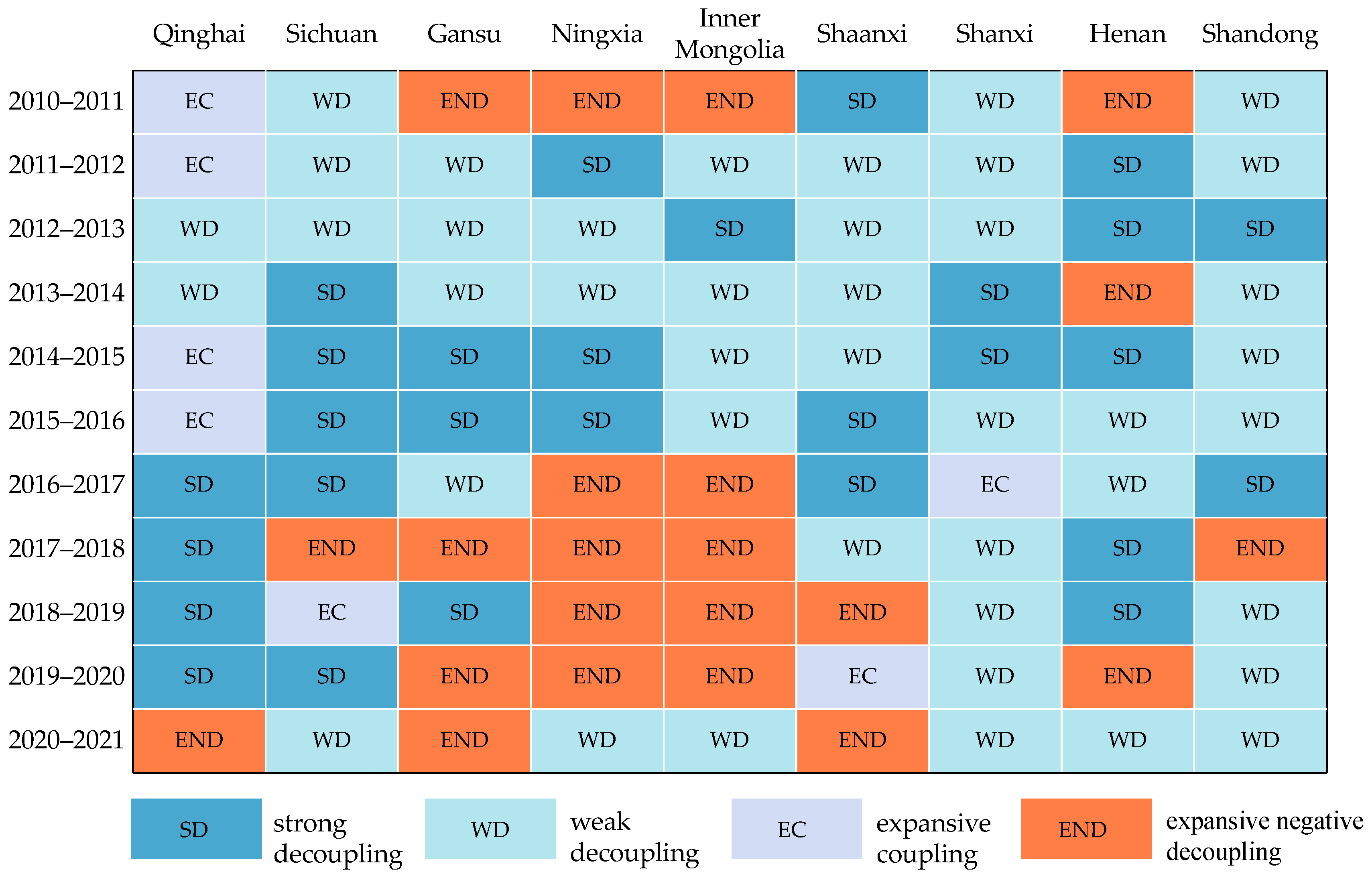
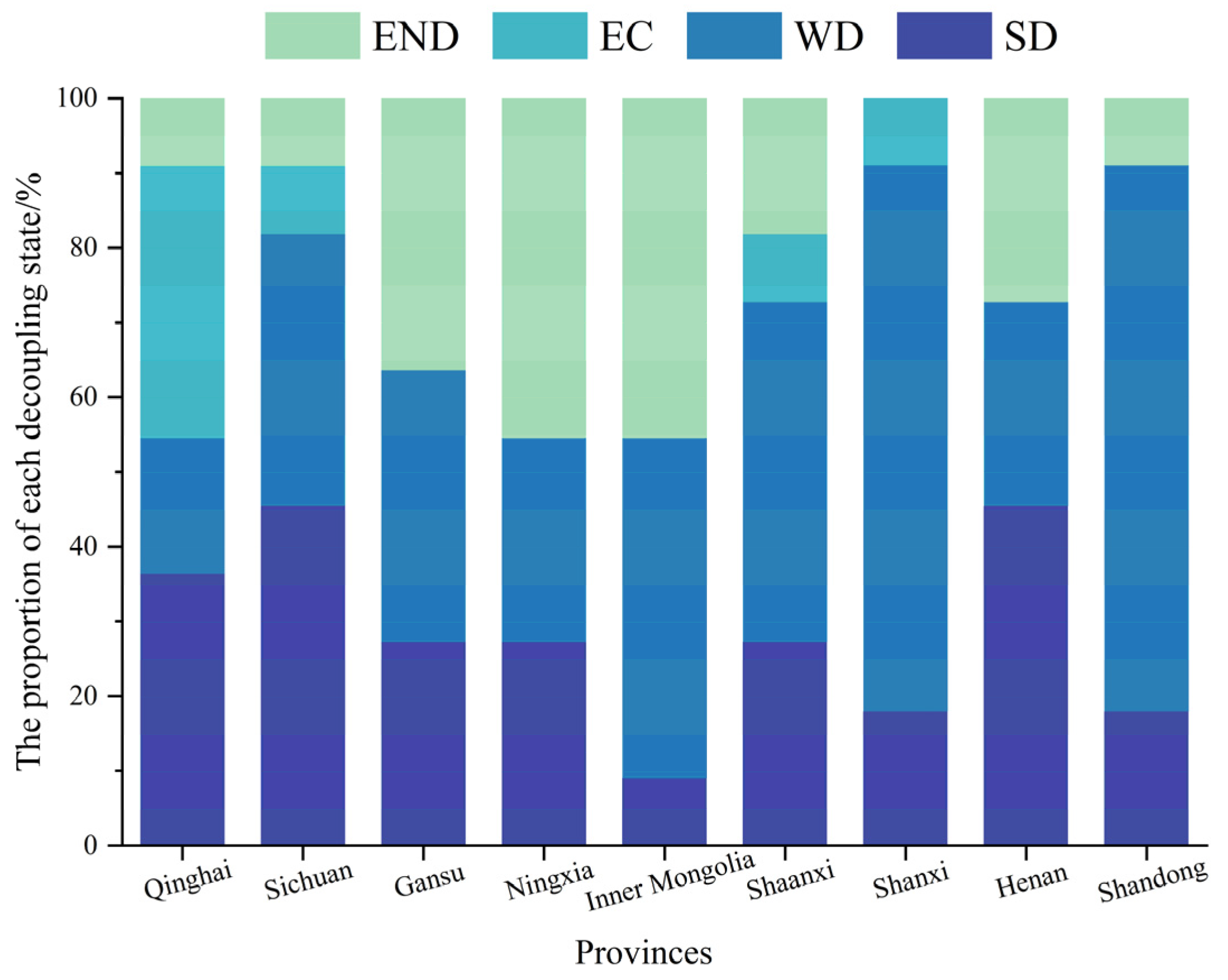
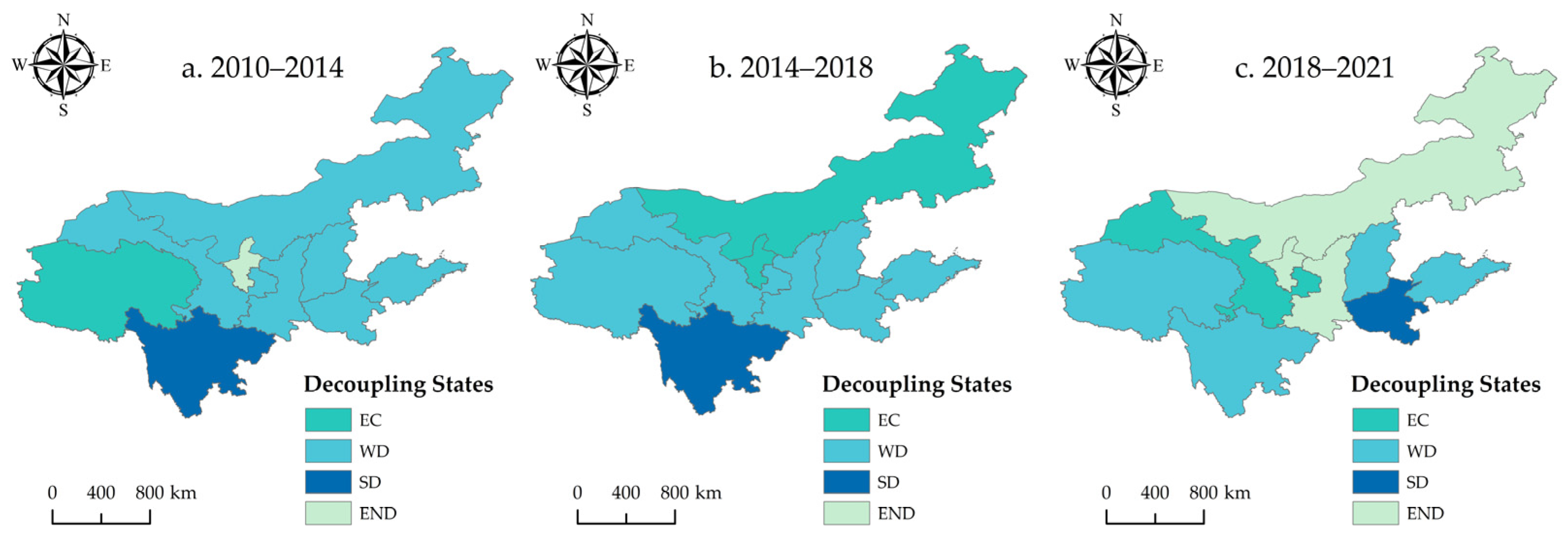
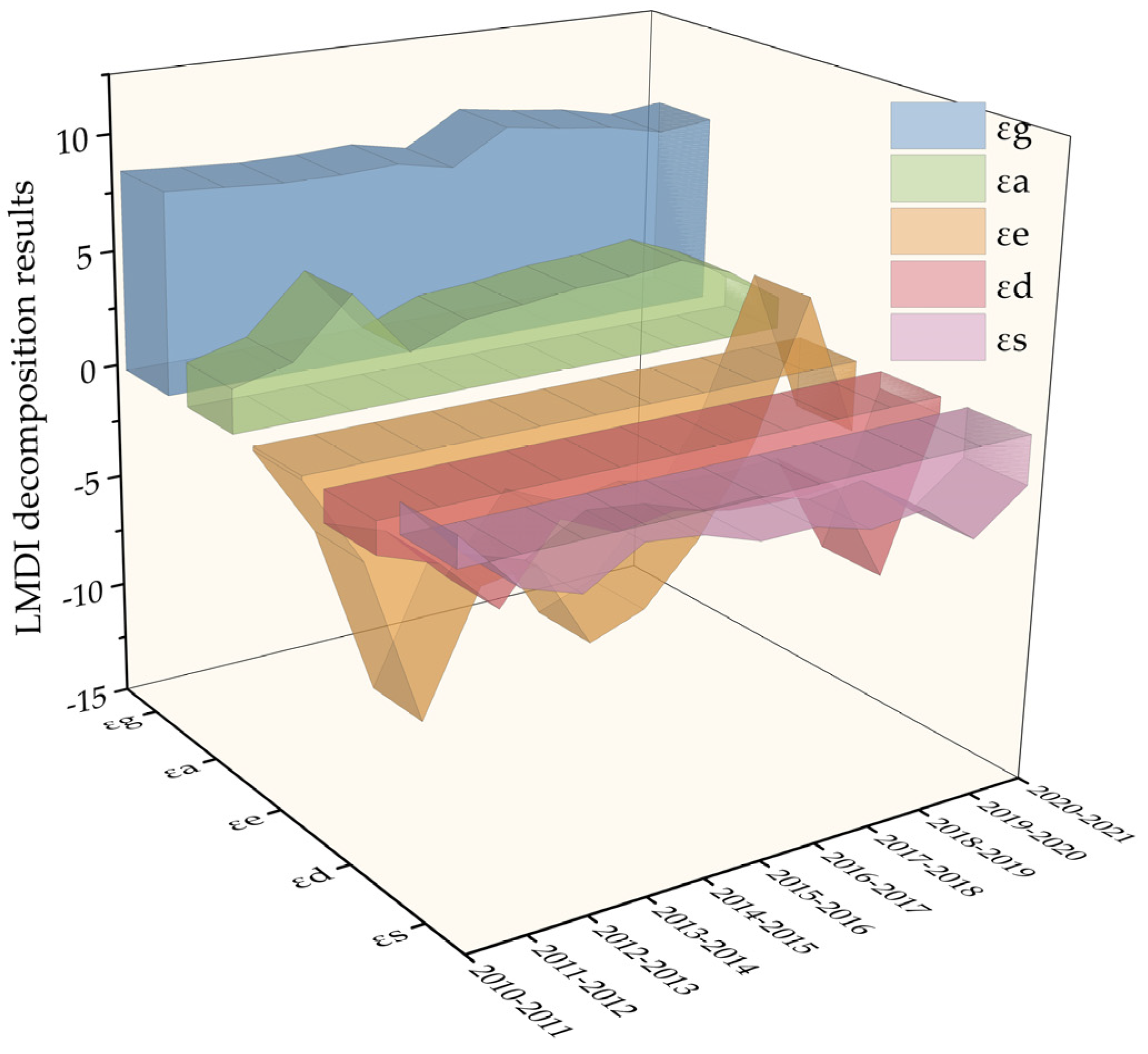
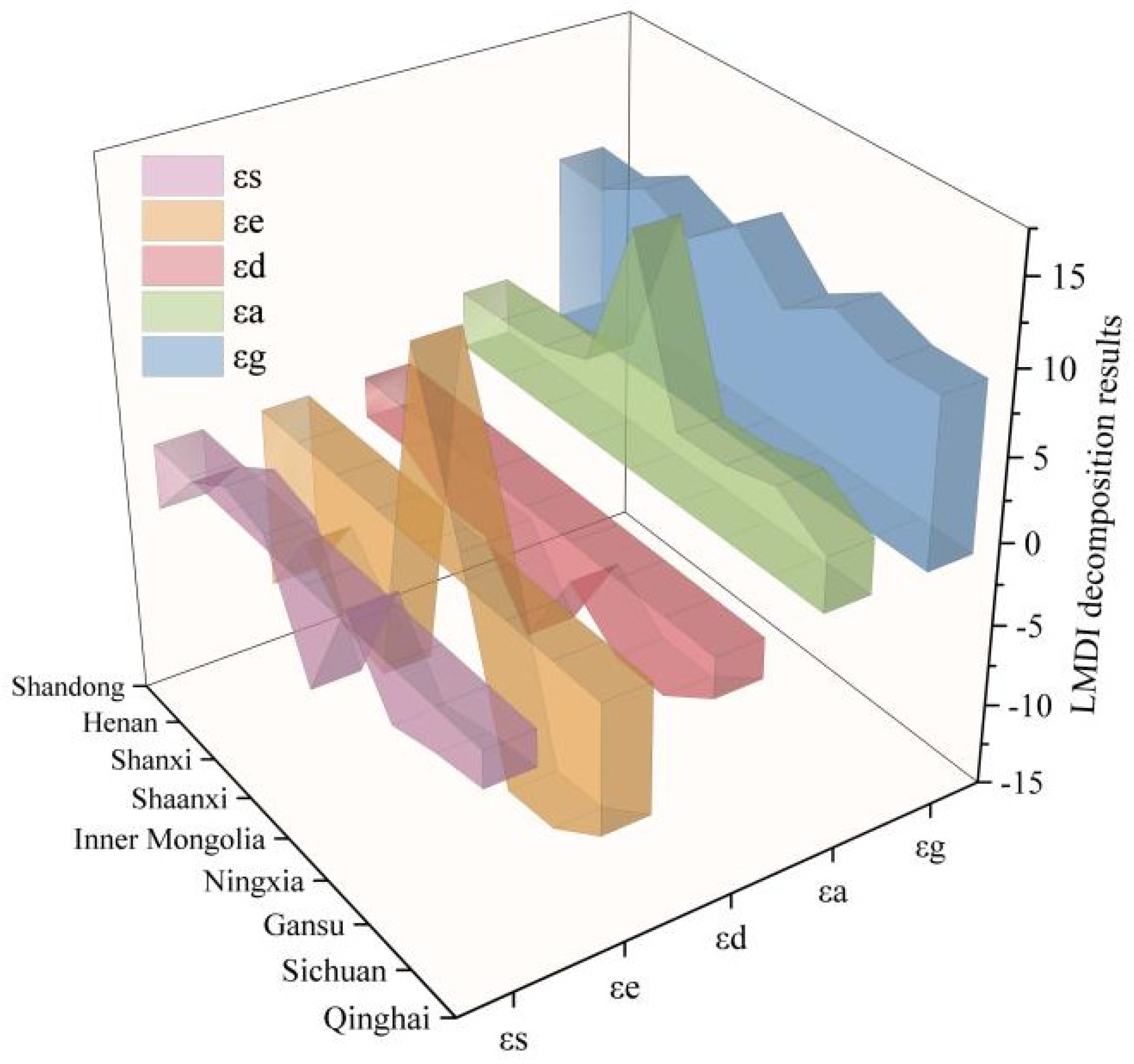
| Energy | Conversion Coefficient of Standard Coal (kgce/kg) | Carbon Emission Coefficient (kgc/kgce) |
|---|---|---|
| Raw coal | 0.7143 | 0.7559 |
| Coke | 0.9714 | 0.8550 |
| Crude oil | 1.4286 | 0.5857 |
| Gasoline | 1.4714 | 0.5538 |
| Kerosene | 1.4714 | 0.5714 |
| Diesel fuel | 1.4571 | 0.5921 |
| Fuel oil | 1.4286 | 0.6185 |
| Natural gas | 13.300 | 0.4483 |
| Year | Center X | Center Y | XStdDist/km | YStdDist/km | Rotation/° | Area/km² | Distance/km | Velosity/km·a−1 |
|---|---|---|---|---|---|---|---|---|
| 2010 | 112°07′15″ | 37°00′52″ | 722.47 | 540.21 | 56.01 | 1,226,060 | - | - |
| 2014 | 111°52′26″ | 37°19′29″ | 735.75 | 554.81 | 53.96 | 1,282,320 | 41.16 | 10.29 |
| 2018 | 112°01′40″ | 37°36′35″ | 709.14 | 562.47 | 57.66 | 1,253,010 | 34.87 | 8.72 |
| 2021 | 111°50′38″ | 37°44′50″ | 715.52 | 566.84 | 51.13 | 1,274,110 | 22.27 | 7.42 |
| Year | ΔC/C | ΔGDP/GDP | Decoupling Index | Decoupling Status |
|---|---|---|---|---|
| 2010–2011 | 0.134 | 0.122 | 1.10 | EC |
| 2011–2012 | 0.023 | 0.105 | 0.22 | WD |
| 2012–2013 | −0.061 | 0.095 | −0.64 | WD |
| 2013–2014 | 0.025 | 0.084 | 0.30 | WD |
| 2014–2015 | 0.002 | 0.076 | 0.03 | WD |
| 2015–2016 | −0.002 | 0.074 | −0.03 | WD |
| 2016–2017 | 0.024 | 0.072 | 0.34 | WD |
| 2017–2018 | 0.079 | 0.070 | 1.11 | EC |
| 2018–2019 | 0.036 | 0.062 | 0.59 | WD |
| 2019–2020 | 0.022 | 0.027 | 0.84 | EC |
| 2020–2021 | 0.034 | 0.074 | 0.46 | WD |
| Year | |||||
|---|---|---|---|---|---|
| 2010–2011 | 0.61 | −0.17 | 8.63 | −1.38 | 1.89 |
| 2011–2012 | −1.47 | −4.12 | 8.45 | −2.27 | 2.53 |
| 2012–2013 | −2.15 | −11.68 | 8.28 | −4.75 | 4.95 |
| 2013–2014 | −0.68 | −6.33 | 8.27 | −1.60 | 2.07 |
| 2014–2015 | −0.97 | −6.00 | 8.39 | −2.72 | 3.02 |
| 2015–2016 | −1.79 | −10.11 | 7.89 | −2.35 | 3.09 |
| 2016–2017 | −1.76 | −9.20 | 8.27 | −2.89 | 3.46 |
| 2017–2018 | −2.43 | −6.60 | 8.73 | −3.03 | 3.26 |
| 2018–2019 | −2.15 | −2.86 | 8.53 | −2.93 | 3.38 |
| 2019–2020 | −5.33 | 3.30 | 9.58 | −9.96 | 2.98 |
| 2020–2021 | −2.20 | −4.20 | 8.36 | −0.77 | 0.80 |
| Total effect | −20.32 | −57.97 | 93.38 | −34.66 | 31.41 |
| Contribution/% | −171.63% | −489.64% | 788.72% | −292.80% | 265.35% |
Disclaimer/Publisher’s Note: The statements, opinions and data contained in all publications are solely those of the individual author(s) and contributor(s) and not of MDPI and/or the editor(s). MDPI and/or the editor(s) disclaim responsibility for any injury to people or property resulting from any ideas, methods, instructions or products referred to in the content. |
© 2025 by the authors. Licensee MDPI, Basel, Switzerland. This article is an open access article distributed under the terms and conditions of the Creative Commons Attribution (CC BY) license (https://creativecommons.org/licenses/by/4.0/).
Share and Cite
Du, Z.; Ren, X.; Zhao, W.; Zhang, C. Spatiotemporal Characteristics of Carbon Emissions from Construction Land and Their Decoupling Effects in the Yellow River Basin, China. Land 2025, 14, 320. https://doi.org/10.3390/land14020320
Du Z, Ren X, Zhao W, Zhang C. Spatiotemporal Characteristics of Carbon Emissions from Construction Land and Their Decoupling Effects in the Yellow River Basin, China. Land. 2025; 14(2):320. https://doi.org/10.3390/land14020320
Chicago/Turabian StyleDu, Zhaoli, Xiaoyu Ren, Weijun Zhao, and Chenfei Zhang. 2025. "Spatiotemporal Characteristics of Carbon Emissions from Construction Land and Their Decoupling Effects in the Yellow River Basin, China" Land 14, no. 2: 320. https://doi.org/10.3390/land14020320
APA StyleDu, Z., Ren, X., Zhao, W., & Zhang, C. (2025). Spatiotemporal Characteristics of Carbon Emissions from Construction Land and Their Decoupling Effects in the Yellow River Basin, China. Land, 14(2), 320. https://doi.org/10.3390/land14020320





